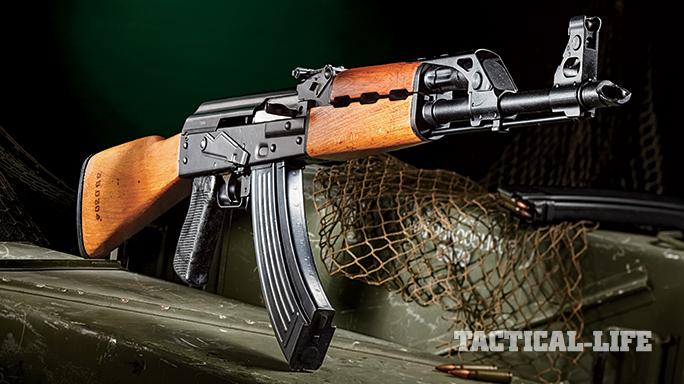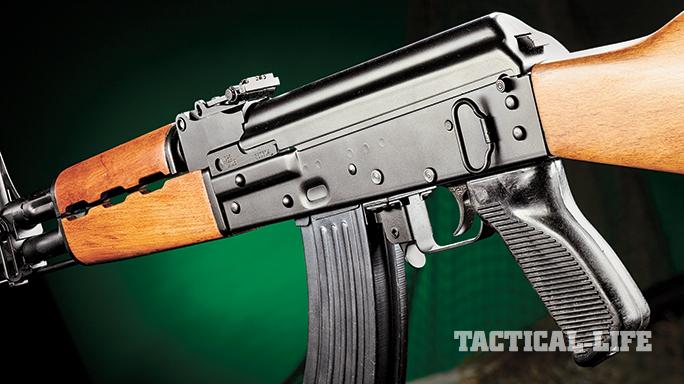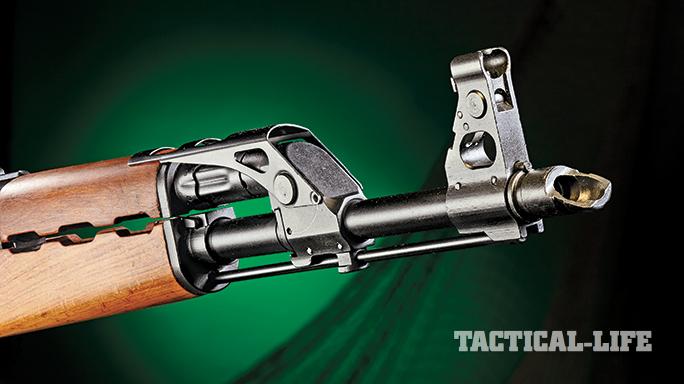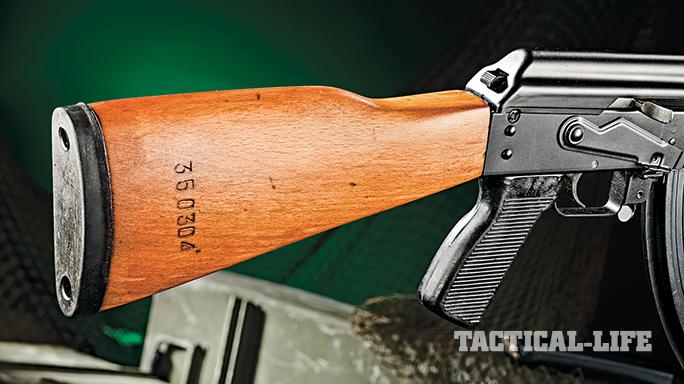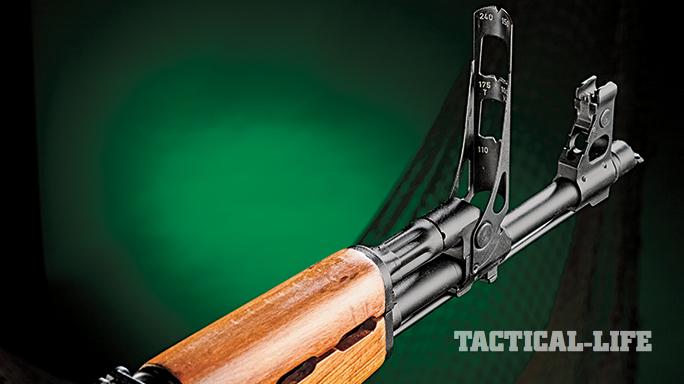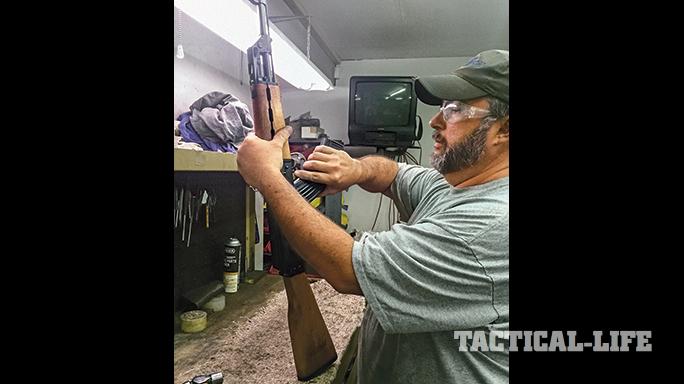For many, “military surplus” encompasses more than simply just firearms. It can be the collecting of accessories and gear such as uniforms and helmets, or even firearms parts and accessories. But how about those unique finds that fit somewhere in between? I am referring specifically to “parts kits,” which more often than not are military guns that are not importable in their original configurations and have been demilled/disassembled and had their barrels and receivers cut.
- RELATED STORY: Yugoslavian M48A | Yugo M48A Mauser Rifle
These kits are in most cases made from small arms that are select-fire or fully automatic in operation and cannot be purchased by civilians in their original form, as compared to bolt-action and semi-automatic rifles and carbines that can be sold in their as-issued configurations.
While there is a good selection of interesting machine gun and submachine gun parts kits available on the surplus market these days, rebuilding these into U.S.-legal semi-automatic firearms can be complicated, expensive or both. However, there is also a large number of AK-pattern parts kits that appear on the surplus market from time to time and have the advantage of being relatively easy (for a skilled gunsmith) to rebuild into a U.S.-legal, semi-automatic rifle.
Advertisement — Continue Reading Below
But where would you find one of these? I personally have had a good deal of luck with Apex Gun Parts after having discovered the company a few years back. In that time, I have picked up some really interesting East German, Hungarian, Polish and Romanian AK kits from the company, and I make sure to keep an eye out on the company’s website for when some new treasure may pop up.
It was during one of these forays that I discovered a kit that I had wanted to pick up for quite a while—a Yugoslav M70 B1 parts kit. It was described as being in excellent condition and featured matching numbers. Yugoslav AKs are unique variants of the Kalashnikov rifle, featuring numerous enhancements over a basic AK-pattern rifle.
I immediately put in an order on the website and began planning out the project. It also occurred to me that this might be an interesting basis for not only an article about the kit I bought, but
also the company itself. To that end, I put in a request with a contact at Apex to get some background information for this piece.
Advertisement — Continue Reading Below
Rare Finds
Apex, which stands for “Armory Parts Exchange,” was founded in 2004 by Jeff Selvig, whom I recently had an opportunity to interview about his company. Selvig, who worked both as an overseer of a bonded warehouse and as a salesman in the distributor section of a major East Coast firearms importer, saw the potential for a new approach to the business.
“I had the opportunity to travel the world and see behind the scenes of the market in surplus firearms during my time there,” Selvig explained. “I noticed that there were many firearm manufacturers, firearms importers and firearms dealers, but not really many specializing in just selling parts. The ones that were tended to be older, established companies that were not making a rapid or successful transition to the digital marketplace.”
Advertisement — Continue Reading Below
Recognizing that there was a growing demand for this type of service in the digital community, Selvig struck out and founded Apex Gun Parts in 2004 in the small town of Palmer Lake in Colorado. “The first products the company sold were mainly comprised of old Mauser parts and bayonets sold through eBay, Gunbroker and website discussion forums,” he told me. “One of the first big deals on parts kits for the company was a batch of U.S. M2HB .50-caliber kits that were imported from the former Yugoslavia.”
In the years since its humble beginnings in 2004, Selvig as president has shepherded the company’s development into the successful venture it is today. “We adopted a saying years ago that ‘We sell customer service in the form of gun parts,’” Selvig said. And this customer-oriented approach has proven to be quite successful, with the company having expanded to the point that, in 2012, it moved to a large warehouse located in Colorado Springs, Colorado.
I was particularly curious to ask Selvig how the company locates such interesting products. “Basically, the surplus industry is dictated by overseas availability. As an example, for years there may be no Hungarian AK parts kits available, and then somewhere, in some office inside the Hungarian Ministry of Defense, there is a decision to replace a certain model and quantity of Hungarian-manufactured AKs. Suddenly, what was once rare is now available in abundance,” he said.
Advertisement — Continue Reading Below
The “Cadillac” of AKs
So now with some insight into the story behind Apex, I moved on to consider the history of the Yugoslav parts kit I had purchased. Yugo AKs are extremely interesting, just as the complex history of Yugoslavia itself is. Yugoslavia followed what has been dubbed the “Third Way” or the “non-aligned” movement, in which the nation sought to find a new path apart from the communism of the East and the capitalism of the West. The result was a distinctly divergent socialist nation with its own unique (yet familiar) firearms.
While not a member of the Warsaw Pact, Yugoslavia nonetheless decided to build its own domestic, unlicensed copy of the AK rifle as it recognized the strengths and merits of the design. Its earliest AK variants were built on milled receivers (as was the case with the Soviet AK due to early issues with producing stamped sheet-steel receivers), with the M64 and the M70 family of rifles in both fixed-stock and underfolding variants. However, in the interests of lowering production costs as well as weight, Yugoslavia eventually moved toward a stamped receiver design with its M70 B1 family of fixed-stock (and underfolding M70 AB1) rifles, with the earliest variants featuring receivers with 1-millimeter-thick walls.
Advertisement — Continue Reading Below
Yugoslav military doctrine placed a great deal of emphasis on the launching of rifle grenades (also apparent in the design of the earlier Yugoslav M59/66 family of SKS-pattern rifles), and the Yugoslav AKs were designed to employ these through the use of a detachable launcher spigot for the threaded muzzle that would work in concert with a folding ladder sight atop the upper handguard/gas tube. However, it was soon discovered that this placed a great deal of stress upon the stamped receiver of the rifle. As a result, the rifles were redesigned to employ a receiver with 1.5mm-thick walls and an RPK-style enlarged portion around the trunnion.
Other unique enhancements of the design include a top cover-retaining button that helps keep the cover in place under the heavy recoil of firing rifle grenades. A push button located at the upper left-rear portion of the receiver must be pressed to remove the non-ribbed top cover. Another unique feature of the Yugo rifles is its sighting system, which at first blush appears to be a standard AK design with a sliding tangent rear unit marked out to 1,000 meters and a winged post front. Closer inspection reveals folding leaf units with luminous inserts—two inserts on the rear leaf and a single on the front. They can be folded down and out of the way when not needed.
Externally, Yugo AKs differ from their Soviet counterparts in several ways. They feature lengthened, three-slot handguards, the aforementioned folding ladder sights atop the handguard, more generously sized pistol grips and rubber buttpads on the fixed buttstocks. Also unique to the Yugo design is an interestingly simple solution to the lack of a bolt hold-open on the standard AK—a magazine with a follower that catches the bolt of the rifle in the open position when it runs empty. However, there is no internal catch inside this Yugoslav rifle and the bolt will simply slam closed when the magazine is removed.
Advertisement — Continue Reading Below
Rebuilding History
With the M70 B1 kit on its way, I set about the process of having it turned into a working, civilian-legal, semi-automatic rifle. From past experience on projects like this, I knew that the build would require a certain amount of U.S.-made parts for the rifle to be Section 922r compliant under current firearm regulations. With a stamped-receiver gun like this, it would take a minimum of six U.S.-made parts to achieve this.
A logical starting point would be a new barrel and receiver, as they were the two primary parts not included with the kit. For the barrel, I ordered a non-chrome-lined AK Builder barrel from Apex when I ordered the kit. For the receiver, I picked up a NoDak Spud NDS-5 M70 B1 receiver designed for this unique rifle and featuring the thicker 1.5mm construction and enlarged RPK-style trunnion area.
Advertisement — Continue Reading Below
That left me with four more parts that I needed to acquire. The next logical step was a new semi-auto fire control group, so I picked a TAPCO G2 Trigger Group (made up of a single-hook trigger, hammer and disconnector), which knocked out three more parts for me. For the final part, I picked up a TAPCO stainless steel gas piston.
For the project itself, I knew exactly whom I should contact—In Range’s Troy Sellars. When I first got into having parts kits custom built into working rifles, I asked around with several of my compatriots in the AK community regarding a skilled builder. Sellars’ name came up as a great source for quality work. Over the years, Sellars has built Romanian, East German, Polish and Bulgarian guns for me, and each of the builds has been stellar. So, I ensured that all of the necessary parts were sent to In Range and waited for Troy Sellars to work his magic.
A few weeks later, a complete and functioning semi-automatic M70 B1 arrived at my local gun shop. The rifle exhibited the quality workmanship I have come to expect from Sellars, with it sporting an attractive satin black moly coating over a Parkerized finish. Sellars also informed me that the stock set was a little rough, so he had Brent Graham freshen up the wood and Darrel Gross coat it. The result was a satin-finished, attractive stock set that matched the rifle beautifully. While inspecting the rifle I noted that the original parts kit not only featured matching numbers, but also that the trunnion was marked as being produced in 1986.
Advertisement — Continue Reading Below
- RELATED STORY: 12 Products That Will Enhance Your AK Rifle
Thanks to Apex Gun Parts, In Range, NoDak Spud and TAPCO, I have been able to add an attractive and interesting AK variant to my collection. If you are looking to locate some rare and interesting parts kits that are available on the market, I recommend you keep an eye out at Apex Gun Parts’ website to see what they may have dug up. You may just find your next treasure there!
For More Information
- Apex Gun Parts: apexgunparts.com; 719-481-2050
- In Range, LLC: inrangec2.com; 865-932-6509
- NoDak Spud: nodakspud.com; 952-942-1909
- TAPCO: tapco.com; 800-554-1445
